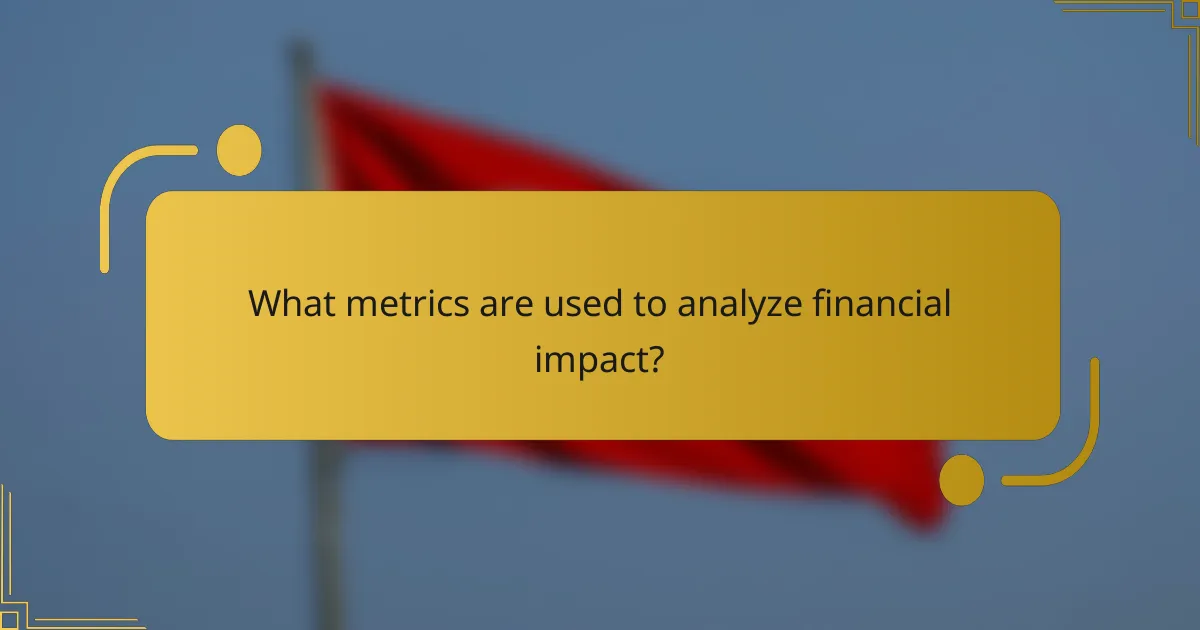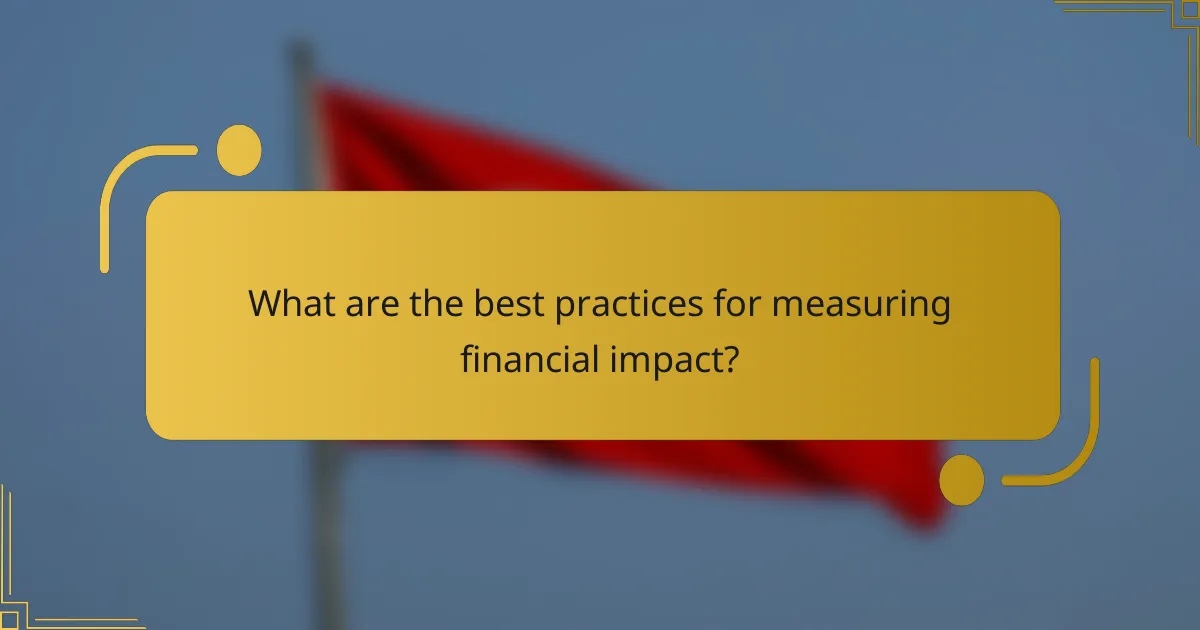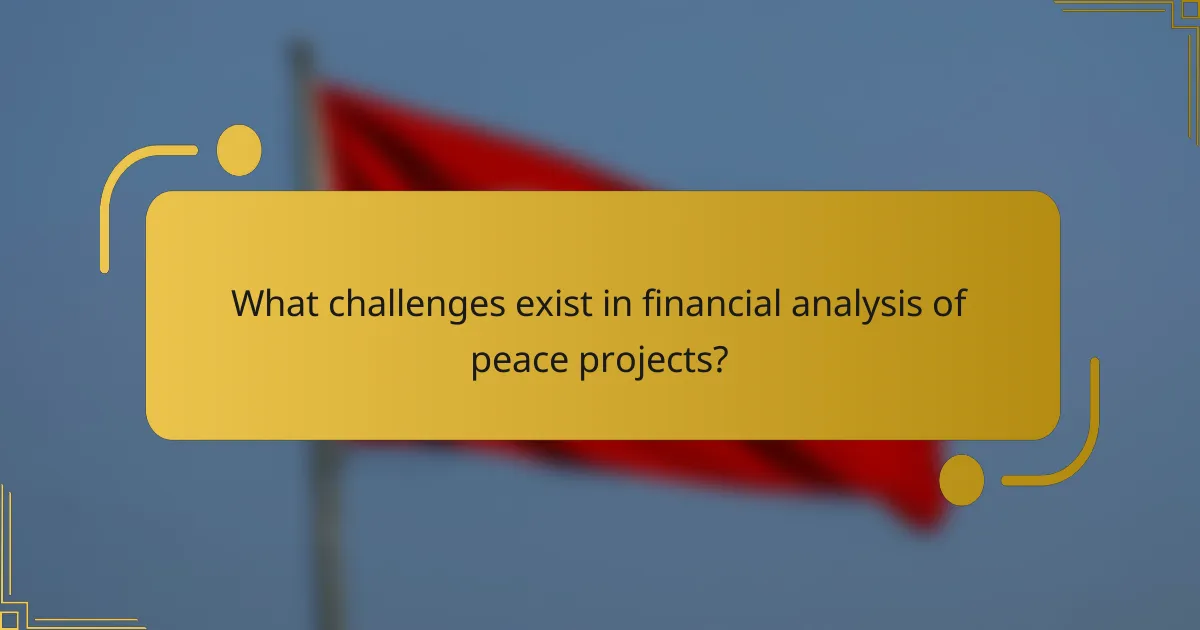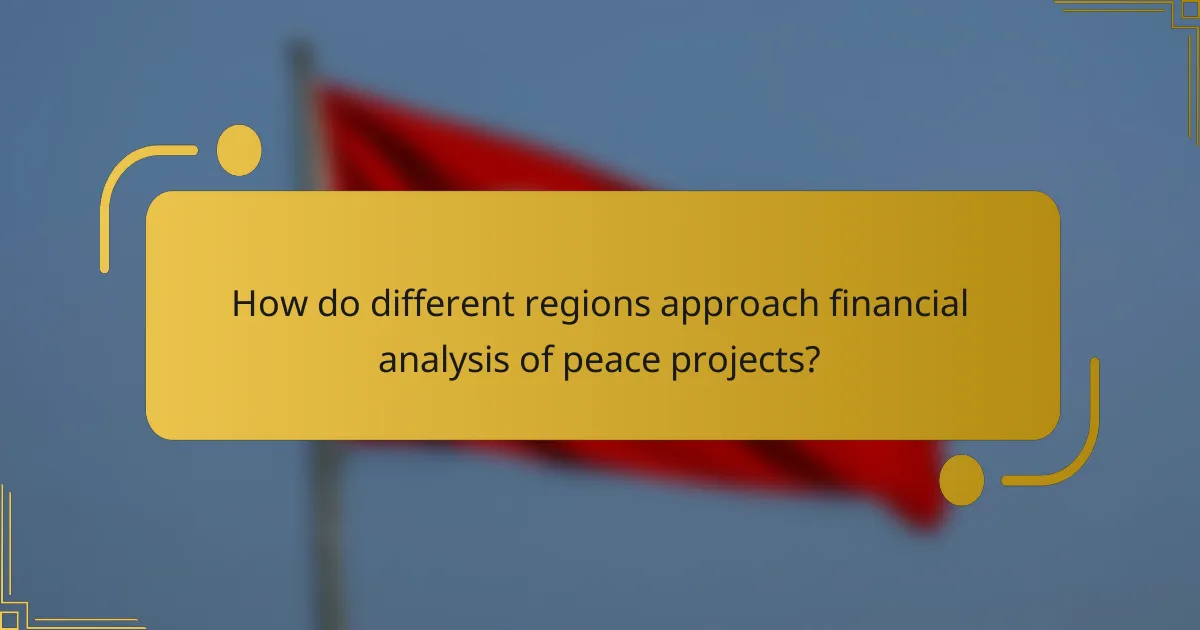The financial impact of peace projects is profound, as they promote stability, attract investments, and lower conflict-related costs. By utilizing metrics such as cost-benefit analysis and return on investment, stakeholders can effectively assess the economic benefits of these initiatives. Comprehensive reporting on the financial outcomes is crucial for understanding the overall effectiveness and implications of peace efforts.

How do peace projects impact financial metrics?
Peace projects significantly influence financial metrics by fostering stability, attracting investments, and reducing costs associated with conflict. These projects create an environment conducive to economic growth, which can be measured through various financial indicators.
Increased economic stability
Peace projects contribute to increased economic stability by reducing uncertainty and fostering a secure environment for businesses. This stability often leads to higher consumer confidence, which can boost spending and investment.
For instance, regions that have successfully implemented peace initiatives often see a rise in GDP growth rates compared to conflict-affected areas. Economic stability can also lead to improved credit ratings, making it easier for governments and businesses to borrow funds at lower interest rates.
Enhanced investment opportunities
With peace comes the potential for enhanced investment opportunities, as investors are more likely to engage in stable environments. Peace projects can create favorable conditions for both domestic and foreign investments, leading to job creation and infrastructure development.
For example, countries that have undergone peace processes often attract foreign direct investment (FDI) that can range from low millions to billions of dollars, depending on the region’s attractiveness. Investors typically look for stable political climates, which peace projects help to establish.
Reduction in conflict-related costs
Peace projects lead to a reduction in conflict-related costs, which can be substantial. These costs include military expenditures, healthcare for conflict-related injuries, and lost economic productivity due to instability.
By investing in peace initiatives, countries can redirect funds from military and security budgets to social and economic development. For instance, nations that have transitioned from conflict to peace often report savings in the hundreds of millions of dollars annually, which can be reinvested into public services and infrastructure.

What metrics are used to analyze financial impact?
Metrics for analyzing the financial impact of peace projects typically include cost-benefit analysis, return on investment (ROI), and social return on investment (SROI). These metrics help stakeholders evaluate the effectiveness and efficiency of funding allocated to peace initiatives.
Cost-benefit analysis
Cost-benefit analysis (CBA) compares the total expected costs of a peace project against its anticipated benefits. This evaluation helps determine whether the investment is worthwhile by quantifying both tangible and intangible outcomes.
When conducting a CBA, consider direct costs such as funding, resources, and personnel, alongside indirect benefits like improved community relations or reduced conflict. A positive ratio indicates that benefits outweigh costs, guiding decision-making for future projects.
Return on investment (ROI)
Return on investment (ROI) measures the financial return generated by a peace project relative to its costs. It is expressed as a percentage and provides a straightforward way to assess the profitability of investments in peace initiatives.
To calculate ROI, use the formula: (Net Profit / Cost of Investment) x 100. A higher ROI suggests a more effective project. For instance, if a project costs $100,000 and generates $150,000 in benefits, the ROI would be 50%, indicating a strong return.
Social return on investment (SROI)
Social return on investment (SROI) expands the ROI concept by incorporating social, environmental, and economic impacts into the financial analysis. This metric quantifies the social value created by peace projects, making it essential for understanding broader implications.
SROI calculations involve identifying stakeholders, measuring outcomes, and assigning monetary values to social benefits. For example, if a peace project reduces violence, the associated healthcare savings and improved quality of life can be factored into the SROI. A typical SROI ratio might range from 1:1 to 3:1, indicating varying levels of social value generated per dollar invested.

How to report financial outcomes of peace projects?
Reporting financial outcomes of peace projects involves systematically documenting the costs, benefits, and overall impact of these initiatives. Clear metrics and frameworks are essential for stakeholders to understand the financial implications and effectiveness of peace efforts.
Standardized reporting frameworks
Standardized reporting frameworks provide a consistent method for measuring and communicating the financial outcomes of peace projects. Common frameworks include the Logical Framework Approach (LFA) and the Theory of Change, which help organizations outline objectives, inputs, activities, outputs, and outcomes.
Using these frameworks allows for easier comparison across projects and can enhance transparency. Organizations should ensure that their chosen framework aligns with donor requirements and local regulations to facilitate funding and support.
Case studies and impact assessments
Case studies and impact assessments are crucial for illustrating the financial outcomes of peace projects. They provide real-world examples of how investments lead to specific results, such as reduced conflict-related costs or improved community resilience.
When conducting impact assessments, consider using both qualitative and quantitative methods to capture a comprehensive view of financial outcomes. This can include surveys, interviews, and financial analysis, allowing stakeholders to see the tangible benefits of peace initiatives.

What are the best practices for measuring financial impact?
Best practices for measuring financial impact involve establishing clear metrics, engaging stakeholders, and utilizing technology for accurate data collection. These practices ensure that the financial outcomes of peace projects are effectively assessed and reported.
Engaging stakeholders in the process
Engaging stakeholders is crucial for accurately measuring financial impact. Involving community members, funders, and local organizations can provide diverse perspectives and insights that enhance the evaluation process. Regular consultations help align project goals with stakeholder expectations and foster transparency.
Consider conducting workshops or focus groups to gather feedback on financial metrics and reporting methods. This collaborative approach can lead to more relevant and accepted measures of success, ultimately improving project outcomes.
Utilizing technology for data collection
Technology plays a vital role in collecting and analyzing data for financial impact assessments. Tools such as mobile applications and online surveys can streamline data gathering, making it easier to capture real-time information from various sources. Utilizing cloud-based platforms can facilitate data sharing and collaboration among stakeholders.
When selecting technology solutions, prioritize user-friendly interfaces and ensure that they comply with data protection regulations. For instance, using software that allows for secure data storage and sharing can enhance trust and participation among stakeholders.

What challenges exist in financial analysis of peace projects?
Financial analysis of peace projects faces several challenges, primarily related to data availability, reliability, and the attribution of financial outcomes. These issues can complicate the assessment of a project’s effectiveness and its overall impact on peacebuilding efforts.
Data availability and reliability
Access to reliable data is a significant challenge in the financial analysis of peace projects. Often, data may be incomplete, outdated, or not publicly available, making it difficult to draw accurate conclusions. For instance, financial records from local organizations may not be systematically documented, leading to gaps in understanding the full financial picture.
To address this, analysts should prioritize collecting data from multiple sources, including government reports, NGO records, and independent evaluations. Using triangulation methods can enhance data reliability, ensuring that findings are based on a comprehensive view of the financial landscape.
Attribution of financial outcomes
Attributing financial outcomes to specific peace projects can be complex due to the multifaceted nature of peacebuilding efforts. Many factors influence financial results, including external economic conditions and social dynamics, which can obscure the direct impact of a project. For example, improvements in community stability may arise from various initiatives, making it hard to pinpoint which financial inputs led to specific outcomes.
To improve attribution accuracy, analysts should employ robust evaluation frameworks that incorporate both qualitative and quantitative measures. Utilizing control groups or comparison regions can help isolate the effects of a peace project, providing clearer insights into its financial impact. Additionally, establishing clear metrics for success at the outset can guide ongoing assessments and enhance accountability.

How do different regions approach financial analysis of peace projects?
Regions vary significantly in their financial analysis of peace projects, influenced by local contexts, funding sources, and stakeholder engagement. While some areas emphasize quantitative metrics, others focus on qualitative assessments to gauge impact and sustainability.
Case studies from Africa
African nations often face unique challenges in financial analysis due to limited data availability and varying economic conditions. For instance, projects in conflict-affected regions may prioritize immediate humanitarian needs over long-term financial metrics, making it difficult to assess overall effectiveness.
Case studies from countries like South Sudan and Somalia illustrate the importance of adapting financial analysis to local realities. In these contexts, metrics such as community engagement and local capacity building are critical, even if they are harder to quantify.
Insights from Southeast Asia
Southeast Asia presents a diverse landscape for financial analysis of peace projects, with countries like Indonesia and the Philippines leveraging both governmental and non-governmental funding sources. Here, financial assessments often incorporate a mix of quantitative data and qualitative insights to evaluate project success.
For example, in the Philippines, peace projects may use metrics such as reductions in violence and improvements in local governance. Stakeholder feedback is also crucial, as it provides context to the numbers and helps ensure that projects align with community needs.

What emerging trends are shaping the financial analysis of peace projects?
Emerging trends in the financial analysis of peace projects focus on integrating advanced technologies and data-driven methodologies to enhance impact assessment. These trends aim to improve the accuracy and effectiveness of financial reporting, ensuring that investments yield meaningful social outcomes.
Integration of AI in impact assessment
The integration of artificial intelligence (AI) in impact assessment is revolutionizing how peace projects are evaluated financially. AI algorithms can analyze large datasets to identify patterns and predict outcomes, allowing for more informed decision-making regarding resource allocation.
For instance, AI can assist in measuring the social return on investment (SROI) by evaluating various indicators such as community engagement, economic development, and conflict resolution effectiveness. This technology can streamline the assessment process, reducing time spent on manual data analysis.
However, organizations should be cautious about data quality and bias in AI models. Ensuring that the data used is representative and accurate is crucial for reliable assessments. Additionally, training staff to understand AI outputs can enhance the effectiveness of these tools in peace project evaluations.

